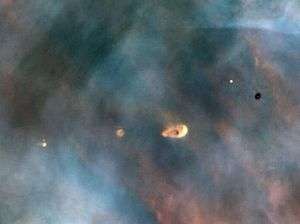Proplyd
.jpg)

.jpg)
.jpg)
.jpg)
A proplyd, a syllabic abbreviation of an ionized protoplanetary disk, is an externally illuminated photoevaporating disk around a young star. Nearly 180 proplyds have been discovered in the Orion Nebula.[1] Images of proplyds in other star-forming regions are rare, while Orion is the only region with a large known sample due to its relative proximity to Earth.[2]
In the Orion Nebula the proplyds observed are usually one of two types. Some proplyds glow around luminous stars, in cases where the disk is found close to the star, glowing from the star's luminosity. Other proplyds are found at a greater distance from the host star and instead show up as dark silhouettes due to the self-obscuration of cooler dust and gases from the disk itself. Some proplyds show signs of movement from solar irradiance shock waves pushing the proplyds. The Orion Nebula is approximately 1,500 light-years from the Sun with very active star formation. The Orion Nebula and the Sun are in the same spiral arm of the Milky way Galaxy.[3][4][5][6]
A proplyd may form new planets and planetesimal systems. Current models show that the metallicity of the star and proplyd, along with the correct planetary system temperature and distance from the star, are keys to planet and planetesimal formation. To date, the solar system, with 8 planets, 5 dwarf planets and 5 planetesimal systems, is the largest planetary system found.[7][8][9] Most proplyds develop into a system with no planetesimal systems, or into one very large planetesimal system.[10][11][12][13][14][15]
See also
References
- ↑ Ricci, L.; et al. (2008). "The Hubble Space Telescope/Advanced Camera for Surveys Atlas of Protoplanetary Disks in the Great Orion Nebula". Astronomical Journal. 136 (5): 2136–2151. Bibcode:2008AJ....136.2136R. doi:10.1088/0004-6256/136/5/2136.
- ↑ Sharkey, Colleen; Ricci, Luca (Dec 14, 2009). "Born in beauty: proplyds in the Orion Nebula" (Press release). Hubble/ESA, Garching, Germany. NASA/ESA. Retrieved Aug 4, 2015.
- ↑ Space Telescope, Born in beauty: proplyds in the Orion Nebula, 14 December 2009
- ↑ Space Telescope, Proplyds
- ↑ Nemiroff, R.; Bonnell, J., eds. (22 December 2009). "Planetary Systems Now Forming in Orion". Astronomy Picture of the Day. NASA.
- ↑ Nemiroff, R.; Bonnell, J., eds. (7 December 1996). "Planetary Systems Now Forming in Orion". Astronomy Picture of the Day. NASA.
- ↑ Windows 2 Universe, Solar System
- ↑ universetoday.com, Solar System, by Matt Williams, 25 June 2016
- ↑ universetoday.com, Inner Planets of Our Solar System, by Matt Williams, 25 June 2016
- ↑ Caltech, Planet-Metallicity Correlation - The Rich Get Richer, by Ji Wang, Planet-Metallicity Correlation
- ↑ The Planet-Metallicity Correlation. 2005, April 200, by Debra A. Fischer, Jeff Valenti
- ↑ arxiv.org, Revealing A Universal Planet-Metallicity Correlation For Planets of Different Sizes Around Solar-Type Stars, by Ji Wang, Debra A. Fischer, 29 Oct 2013
- ↑ Astrobiology Magazine, astrobio.net, When Stellar Metallicity Sparks Planet Formation, By Ray Sanders, 9 April 2012
- ↑ From Lithium to Uranium (IAU S228): Elemental Tracers of Early Cosmic Evolution By International Astronomical Union. Symposium, by Vanessa Hill, Patrick Francois, Francesca Primas, page 509-511, "the G star problem"
- ↑ Oxford Journals Dynamics and accretion of planetesimals, by Eiichiro Kokubo1 and Shigeru, June 14, 2012